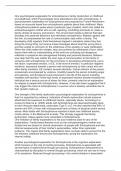One psychological explanation for schizophrenia is family dysfunction in childhood
and adulthood, which Psychologists have attempted to link with schizophrenia. A
psychodynamic explanation for schizophrenia was proposed by Fromm-Reichmann
based on accounts heard from schizophrenic patients about their childhood. Many
schizophrenia patients spoke about a particular type of patent, which she called the
schizophrenogenic mother who is cold, rejecting, controlling and tends to create a
family climate of secrecy and tension. This environment leads to distrust that later
develops into paranoid delusions and ultimately schizophrenia. Bateson agreed with
this link, but emphasised the role of communication style within a family. The
developing child regularly finds themselves trapped in situations where they fear
doing the wrong thing, but receive mixed messages about what this wrong this is,
and feel unable to comment on the unfairness of the situation or seek clarification.
When the child makes the mistake, they are punished by withdrawal of love, which
leaves them with an understanding of the world as confusing and dangerous,
reflected in symptoms like disorganised thinking and paranoid delusions. Bateson
was clear that this was neither the main type of communication in the family of
someone with schizophrenia nor the only factor in developing schizophrenia, just a
risk factor. expressed emotion, or EE, is the level of emotion, in particular negative
emotions, expressed towards a person with schizophrenia by their carers who are
often family members. EE contains several elements: Verbal criticism of the person
occasionallv accompanied by violence, Hostility towards the person including anger
and rejection, and Emotional overinvolvement in the life of the person including
needless self-sacrifice.These high levels of expressed emotion directed towards the
individual are a serious source of stress for them, primarily used as an explanation
for relapse in people with schizophrenia. However, it has also been suggested that it
may trigger the onset of schizophrenia in a person who is already vulnerable due to
their genetic make-up.
One strength of the family dysfunction psychological explanation for schizophrenia is
that it is supported by evidence. Indicators of family dysfunction include insecure
attachment and exposure to childhood trauma, especially abuse. According to a
review by Read et al. (2005) adults with Schizophrenia are disproportionately likely
to have insecure attachment, particularly Type C or D. He also reported that 69% of
women and 59% of men with schizopnrenta have a history of physical and/or sexual
abuse. Most adults with Schizophrenua reported at least one childhood trauma,
mostly abuse, in the Mørkved et al study. This strongly suggests that family
dysfunction makes people more vulnerable to Schizophrenia.
One limitation of family explanations is the poor evidence base for any of the
explanations. Family-based theories such as the schizophrenogenic mother and
double bind are based on clinical observation of people with Schizophrenia and also
informal assessments of their mother’s personalities, rather than systematic
evidence. This means that family explanations have not been able to account for the
link between childhood trauma and Schizophrenia, giving the explanation low
internal validity.
Another psychological explanation for Schizophrenia is the cognitive explanation,
which focuses on the role of mental processes. Schizophrenia is associated with
several types of dysfunctional thought processing. Schizophrenia Schizophrenia is
characterised by disruption to normal thought processing, which we can see in many
of its symptoms. Reduced thought processing in the ventral striatum is associated





